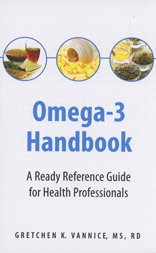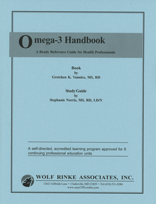|
Omega-3 Handbook: A Ready Reference Guide for Health Professionals
Book by Gretchen K. Vannice, MS, RD
Study Guide by Stephanie Norris, MS, RD, LD/N
| C234 |
8 CPEUs |
HARD COPY |
DISCONTINUED
|
(Book, 107 pgs and study guide, 30 pgs.) This handy reference guide offers dietitians, other health professionals and savvy consumers an easy way to learn about the importance of omega-3 fatty acids.
- Why are omega-3s crucial in health and disease?
- What is the real difference between marine and plant sources?
- How much omega-3 do we need to be healthy?
- Can we get sufficient amounts of omega-3 from foods?
- Are there quality standards for fish oil supplements?
- How do I best advise my vegetarian and/or pregnant clients?
- What amounts should I recommend (or take)?
The Omega-3 Handbook provides comprehensive and easy-to-understand explanations, valuable reference tables, and answers to frequently asked questions. It will help nutrition counselors guide their clients on how to make informed choices and select the best products for their health needs.
For more information and customer comments, click
here.
Approved/Accepted by CDR,CBDM
For RDs & DTRs: Suggested Learning Need Codes for the Prof.
Dev. Portfolio:
2000, 2070, 2090, 3100, 4000, 4040, 4110, 4130, 5000, 5160, 5420, 6020
Share with a friend and Save!
Click here for important information about
sharing.
To order an additional Reporting Form click below:
| C234F |
8 CPEUs |
REPORTING FORM |
$30.00 |

|
Omega-3 Handbook:: A Ready Reference Guide for Health Professionals
Book by Gretchen K. Vannice, MS, RD
Study Guide by Stephanie Norris, MS, RD, LD/N
©2012 Wolf Rinke Associates. No part of this
publication may be reproduced, stored in a retrieval system, or transmitted
in any form or by any means, electronic, mechanical, photocopying,
recording, scanning, or otherwise, without the prior written permission
of the Publisher.
CUSTOMER COMMENTS
Ravit Arvilli: "Easy to understand, concise and a very resourceful handbook. It will help all of us a lot in counseling patients about Omega 3 Fatty acids."
Patricia collette: "Fatty acids or the study of lipids is complicated and not usually easy to understand. This handbook made it easy and user-friendly to understand the science of Omega-3 fatty acids."
Gina Yates: It was very interesting...learned some things that I didn't know.
Nicole Reynolds: "Great guideline for food sources and supplements. My clients often have questions about which supplement to choose and this handbook breaks it down nicely as what to look for."
OVERVIEW AND INTRODUCTION
Welcome to the self-directed accredited learning program for Omega-3 Handbook. The program consists of a book of the same title by Gretchen K. Vannice, MS, RD and this study guide. The program is designed to help you understand the principles of omega-3 nutrition and apply these to your patients’ situations. It is also designed to help you earn 8 Level 2, Continuing Professional Education Units (CPEUs).
To get the most out of this self-directed accredited learning program, it is suggested that you adhere to the following four steps:
Step 1: Review the objectives in this study guide.
Step 2: Read and study the Omega-3 Handbook.
Step 3: Assess what you have learned by answering the questions contained in this study guide.
Step 4: Compare your answers to the answer key provided in this study guide. If you score at least 80% (40 questions) correct, you are ready to transfer your answers to the CONTINUING PROFESSIONAL EDUCATION (CPE) REPORTING FORM. If you scored less than 80% correct, re-read the book until you score at least 80% correct.
After you have successfully completed the program, complete the CPE REPORTING FORM and:
Submit on-line at www.easyCPEcredits.com.
Or fax to: (410) 531-9282,
Or mail to: Wolf Rinke Associates, 721 Valley Forge Road #486, Valley Forge, PA 19481
We will email your Certificate of Completion.
When you submit your CPE Reporting Form to us via mail, fax or www.easyCPEcredits.com, be sure to write your correct email address in the space provided on the CPE Reporting Form. If writing by hand, be sure to print your email address clearly.
To ensure that our emails are delivered to your inbox (instead of your junk/spam folders), please add cpesupport@wolfrinke.com to your Address Book or Safe List of allowed email senders. Also, be sure to allow attachments from this email address.
Enjoy the Omega-3 Handbook!
LEARNING OBJECTIVES
Upon completion of this accredited, self-directed learning program, the nutrition professional will be able to:
- Distinguish between the different types of omega-3 fatty acids;
- Identify foods that provide the different types of omega-3 fatty acids;
- Use findings from recent research on diet in counseling clients about omega-3 fatty acids and strategies for cardiovascular health;
- Communicate potential health benefits of omega-3 fatty acids;
- Pinpoint potential areas of difficulty in meeting nutritional needs, along with solutions for obtaining adequate omega-3 fatty acids;
- Apply knowledge about functions and interactions of omega-3 fatty acids to identify potential deficiencies in various dietary patterns;
- Assist clients in meeting recommended omega-3 fatty acid intakes;
- Discuss the advantages of fish sources of omega-3 fatty acids compared to vegetarian sources;
- Identify the variations in types of omega-3 fatty acids that help explain risk for chronic diseases;
- Calculate how much fish or how many fish oil supplements need to be consumed to reach recommended amounts of EPA and DHA in healthy individuals;
- Estimate EPA and DHA fatty acid content of various omega-3 sources;
- Identify the US Recommended Daily Value of omega-3 fatty acid and compare those values to other health organization recommendations;
- Suggest ways for vegetarians to increase intake of DHA;
- Describe various ways clients can meet EPA and DHA recommendations using either food, supplementation, or fortified foods;
- Make appropriate recommendations for meeting omega-3 fatty acids needs based on individual lifestyle;
- Evaluate short and long chain omega-3 fatty acids and food sources for each;
- Identify strategies for consuming adequate omega-3 fatty acids on a weekly basis;
- Suggest techniques parents can use to increase omega-3 fatty acid consumption in children;
- Assist women who are pregnant to safely consume fish;
- Address environmental concerns regarding fish sources and contamination;
- Discuss how to interpret information regarding omega-3 fatty acids on food labels.
TABLE OF CONTENTS
An Introduction to Omega-3s..................................................... 1
Research overview ................................................................... ....2
The four omega-3s........................................................................ 3
ALA/SDA and conversion............................................................. 5
Biological functions of EPA and DHA: A brief overview................. 7
Intake and recommendations......................................................... 7
Increasing blood levels of EPA and DHA..................................... 11
Measuring omega-3 blood levels.................................................. 11
The importance of a healthy ratio of omega-3 to omega-6... ........ 12
Safety consideration: Blood thinning............................................. 14
Frequently asked questions.......................................................... 15
Getting Omega-3 from Foods.................................................. 23
The basics................................................................................... 23
More about marine sources......................................................... 26
More about plant sources............................................................ 30
Fortified foods............................................................................ 35
Frequently Asked Questions.................................................... ... 40
Dietary Supplements................................................................ 51
Choosing and recommending supplements.......................... ......... 51
Marine sources............................................................................ 52
Advising vegan and vegetarian clients........................................... 57
Antioxidants and other details about fish oil supplements............... 58
Behind the fish oil curtain............................................................. 62
Quality differences in fish and marine oil supplements.................... 64
Production of vegetarian supplements.......................................... 65
Reading the label......................................................................... 66
Storing fish oil: Capsules vs. liquid............................................... 70
Fish burps or repeat.................................................................... 71
Independent or 3rd-party testing................................................. 72
Prescription fish oil...................................................................... 72
Borage, evening primrose, and black currant oils.......................... 73
Frequently asked questions.......................................................... 74
Resources................................................................................. 85
Recommended Intake Tables...................................................... 85
American Dietetic Association and Dietitians of Canada:
Omega-3 Fatty Acid Recommendations...................................... 85
American Heart Association Omega-3 Fatty Acid
Recommendations....................................................................... 86
American Psychiatric Association Omega-3 Fatty Acid
Recommendations....................................................................... 87
Global and Select Countries: Omega-3 Fatty Acid
Recommendations for the General Adult Population..................... 88
Recommendations and Daily Intakes for DMA for
Pregnant and Lactating Women................................................... 91
Recommendations and Daily Intakes for EPA and DHA for
Children...................................................................................... 93
GOED Manufacturing Standards for Fish Oil............................... 94
Where the Story Begins: References............................................ 97
Additional Resources.................................................................. 98
Useful Client Tools................................................................. 101
Author's Bio and Contact Information................................... 107
ABOUT THE AUTHOR OF THE BOOK
Gretchen Vannice, MS, RD, is an independent nutrition research consultant specializing in preventive health and evidence-based nutrition science. For the past 10 years she has worked and studied omega-3 fatty acids in collaboration and consultation with universities, industry, and healthcare. She is the author of the Omega-3 Handbook: A Ready Reference Guide for Health Professionals (www.omega3handbook.com).
Ms. Vannice is an international speaker and trainer on omega-3 fatty acids, and serves as the chair of the International Science Committee of the Global Organization for Omega-3 EPA and DHA (GOED). She is also a member of the International Society for the Study of Fatty Acids and Lipids (ISSFAL).
A former health educator at Kaiser Permanente in Northern California, Ms. Vannice has been an executive board member of Dietitians in Integrative and Functional Medicine, a practice group of the Academy of Nutrition and Dietetics. She was awarded the group’s “Excellence in Practice Award” in 2007.
Ms. Vannice has authored numerous articles and chapters, often by invitation. Her work appears in Krause’s Food and Nutrition Care Process, 13th ed. (Elsevier, 2011), the Journal of Applied Nutrition, and the Journal of the Academy of Nutrition and Dietetics. She presented at the 2010 and 2011 Food and Nutrition Conference and Exhibition of the Academy of Nutrition and Dietetics.
Her career has been highlighted twice in academic textbooks: The Profession of Dietetics, a Team Approach, 4th. ed (Jones and Bartlett, 2011) and Nutrition Therapy and Pathophysiology (Cengage Learning, 2011).
Gretchen Vannice is a 4th generation Oregonian, based in Portland, Oregon.
ABOUT THE AUTHOR OF THE STUDY GUIDE
Stephanie Norris, MS, RD, LD/N completed her undergraduate work at Florida State University in Nutrition and Dietetics and her graduate work at the University of Central Florida in Health Care Administration where she received the “Outstanding Graduate Student Award.”
Ms. Norris is certified in Child and Adolescent Weight Management. She is an adjunct teacher at the University of Central Florida and Valencia College. Her career in nutrition and dietetics includes a wide range of experience from clinical dietetics to marketing of nutrition education and research to health professionals with the Dairy Council of Florida.
Ms. Norris is a member of the Academy of Nutrition and Dietetics (formerly the American Dietetic Association) where she has served as Secretary and President of the Florida affiliate. Other leadership positions include: Chair of the Board of Directors for Hebni Nutrition Consultants and a member of the Nutrition Committee for Second Harvest Food Bank of Central Florida.
Return to the top of page
If you prefer to order by phone, mail
or fax click below
or click here to contact us with
other questions.
For information about our other products and
services return to the sidebar at the top of the page.
|



